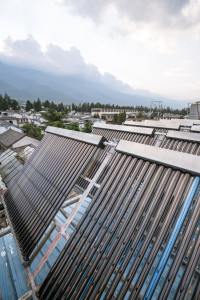The problems encountered by the Solana Generating Station, a solar thermal facility, illustrate that sponsors may be able to negotiate for a favorable position despite operating at well below the agreed upon output. For example, Solana has experienced fluid leakage and fires due to the intense heat generated by its mirrors. Although not publically available, it seems that the sponsor, Abengoa,
 Arizona’s deserts have become home to enormous solar stations, financed through a mix of contributions from large developers, tax equity and debt investors; but what happens when these massive systems don’t operate according to plan? For example, according to the U.S. Energy Information Administration, the Solana Generating Station, a recipient of the Department of Energy (DOE) Loan Guarantee Program that became operational in late 2013, generated less than 70% of its estimated capacity last year. Although even the best solar projects can never be entirely de-risked, project participants can avoid worst-case scenarios with well negotiated project documents that address both problems and workable solutions.
Arizona’s deserts have become home to enormous solar stations, financed through a mix of contributions from large developers, tax equity and debt investors; but what happens when these massive systems don’t operate according to plan? For example, according to the U.S. Energy Information Administration, the Solana Generating Station, a recipient of the Department of Energy (DOE) Loan Guarantee Program that became operational in late 2013, generated less than 70% of its estimated capacity last year. Although even the best solar projects can never be entirely de-risked, project participants can avoid worst-case scenarios with well negotiated project documents that address both problems and workable solutions.
Non-Performance Risks Allocated in Project Documents
In many large-scale projects, the developer/project sponsor contracts with a utility to supply it with electric power, and the utility usually purchases electricity at a certain rate per kilowatt/hour (kWh) for a contracted term. This type of agreement, usually in the form of a Power Purchase Agreement (PPA), ensures a predictable and stable revenue stream, which allows the sponsor/developer to raise the debt to finance construction. The sponsor/developer is usually on the hook to provide the utility with a certain megawattage of power, and dipping below an agreed upon range is typically a breach of the PPA.
There typically are two contracts in which potential performance deficiencies can be addressed. The first is in the engineering, procurement and construction (EPC) agreement. Here, the deal sponsor/developer normally contracts with an EPC firm to build the physical project. At a set date, the EPC hands over a built and functioning project that can meet the standards contracted for in the PPA with the utility, likely including a megawatt value that the facility is expected to generate. If the EPC fails to achieve the contracted megawattage during the system’s testing, the EPC must pay liquidated damage to compensate the sponsor due to injury caused by the delay. Such EPC guarantees also may extend for a period of time during operation, often for one year. This arrangement may prevent the sponsor from defaulting on its loan because it allows the sponsor to charge the EPC for late or faulty work while receiving funds to cover debt service. Additionally, in some instances, sponsors can negotiate that the risks, damages and remedies under the PPA are passed along to or mitigated by the EPC contractor in order to minimize developer liability.
While it is useful to address deficiencies in an EPC Agreement, there are situations in which the EPC contractor will not be on the hook for the type of problem that has developed, or is not in an economic position to pay liquidated damages. Therefore, addressing deficiencies in the contract directly with the power purchaser is also essential. The most precarious scenario for a project company is if the offtaker can terminate or cancel the PPA due to a failure to perform. Such provisions may be deal-breakers for many debt providers, and, even if debt is obtained, it could create challenges in meeting debt service and other obligations under the loan agreement. To address this potential situation, developers should negotiate generous cure periods into their PPAs to allow time to remedy capacity issues, and a force majeure provision that includes a broad range of scenarios that are defined as beyond the sponsor’s control.
The problems encountered by the Solana Generating Station, a solar thermal facility, illustrate that sponsors may be able to negotiate for a favorable position despite operating at well below the agreed upon output. For example, Solana has experienced fluid leakage and fires due to the intense heat generated by its mirrors. Although not publically available, it seems that the sponsor, Abengoa, contracted for this risk, thus alleviating some of the headache by drafting the PPA in a manner that anticipated the facility’s production would be lower during its initial years of operation.
Conclusion
Project agreements should work in tandem to create smooth operation long term, potentially the 20 to 30 years of a solar system’s life. Clearly allocating project risks, providing incentives for good work and allowing counter-parties a reasonable timeframe to mitigate errors increases the likelihood that a project remains financed and that the developer can meet its debt repayment schedule. Additionally, carefully considered and negotiated project documents that are not at cross-purposes can prevent costly litigation and enable an underperforming project to be brought up to performance standards.


.jpg?width=220&name=Sullivan%204c(B2402503).jpg)